Methods
Deep Stretch Therapy
_________________________________________________________________
Deep Stretch therapy is our unique blend of methods designed to find the root of your problem, refocus your foundation, and set you up for long term results. If you’re reading this, you can tell. There’s some deep soreness or pain just stuck in there! Something is trapped, stuck somewhere inside your body keeping you from moving the way you know you can move. Sometimes it can be stretched away. Sometimes it just goes away on its own. But if your pain persists, or your soreness just wont go away, you need to listen to your body. That’s why ESOTONE – Deep Stretch Therapy, was created.
Here’s how it works: Your body remembers pain through patterns that are kept in your muscles and connective tissue. If you do something your body doesn’t like, like sit for an extreme amount of time, injure it, or do something repetitive for too long, your survival brain decides – you’re better off with that area locked down instead. The same thing happens when you break a limb, just not as extreme. Your body is trying to tell you something. It’s creating an ‘internal cast’. Your brain says, “hey body, I think we would be in less pain if we just can’t move anymore”. At that point, climbing upstairs quickly feels like challenging Mount Everest.
If left untreated, deep soreness and stored pain typically results in; more pain, low energy, headaches, less mobility, low back pain, knee pain, shin splints, nerve compression, piriformis syndrome, plantar fasciitis ect. An integral key to pain lives in the global network of connective tissues that glue together all of the body’s innerworkings and provide our bodies with integrity and function called: ‘fascia’. Fascia is important for two main reasons:
- When functional, fascia acts like a lubricant for joints and muscles. When in dysfunction, fascia gets sticky acting like a glue for fatigued muscles and creaky joints. If left untouched, the glue can spread to other areas, get stickier, or even act like cement!
- Many chronic injuries such as, bulging discs and meniscal knee pain, happen because of time and gravity, or a lack of structure. The way fascia provides our body structure is called, ‘tensegrity’. Tensegrity is a term that comes from architecture. It is essentially the combination of tension and integrity. In a tensegrity model, bands pull at rods from various angles, giving the model structure. In your body, the bands are fascia, and the rods are bones. Having healthy tension patterns keep us standing upright with good posture, while dysfunctional patterns result in pain and poor posture.
Our methods target strategic points throughout the entire body. Sore spots, knots, and adhesions are melted along the way in order to bring the body back to balance. The secret is: ‘steady pressure’. When you stay still on a knot, you bring blood to the area. Blood acts as lubricant for stuck muscles and creaky joints. Muscles that are stuck in an active state are convinced to relax, while other muscles that are stuck in an overly relaxed state are convinced to activate. The brain remembers, “hey, I forgot all about that muscle! Maybe it’s safe for that area to move again?”. The result is restored mobility, newfound ability, and an escape from the unescapable chronic pain cycle!
If you are in the Sacramento area or you’re just intrigued about the process and techniques used at ESOTONE, do not hesitate to contact us and set up your own personal massage or just spark a conversation with yours truly. Below is a full list of the modalities practiced at ESOTONE. Please read, share, and comment at the bottom of this page. I would love to get a conversation going! If you’re looking for free information and instructional home stretching videos, click here. Thanks for reading!
– Zachary Kwiker CMT
Self Myofascial Release (SMR)
YOUR body is trying to tell YOU something. Therefore, sometimes you are your best therapist. That’s the purpose of Self Myofascial Release (SMR). The term was first coined in the 1960’s by one of the founding creators of Myofascial Release. And foam rollers weren’t regularly implemented until 1987. SMR allows you to replicate ANY of the Deep Stretch Therapy methods! It just takes a ball and a roller! The trick is steady pressure and deep breathing.
Knots can be painful and cause a myriad of dysfunction. It can be frustrating when you think one spot is keeping you from a good nights sleep or a productive work day. Instead of trusting a therapist to do the work, you can put matters into your own hands! The trick is knowing the right positions and understanding what a release feels like. It should feel exactly like the massage technique it’s designed to replicate.
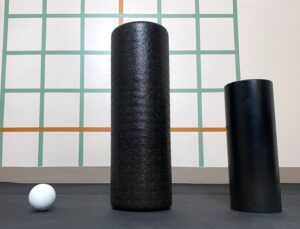
If you do a google search for SMR techniques, you’ll find specialty trigger point release balls, spiky balls that look like dog toys, foam roller, foam rollers with spikes covering them, and even power drills with a rubber ball on the tip. The truth is, you don’t need any of them to get the release you’re after. The only tools you need are a lacrosse ball, a tennis ball, a foam roller, and a PVC pipe. The lacrosse ball and tennis ball provide a steady point and act like the therapists elbow. the foam roller or PVC pipe act like the therapists forearm. Instead of applying pressure downward from above your body like a therapist would, you apply pressure using your own body weight and your positioning allows you to control pressure with the proper detail needed for your ideal release.
For a list of SMR release positions and videos designed specifically for Deep Stretch Therapy, click the link below.
Active and Passive Release Techniques (ART)
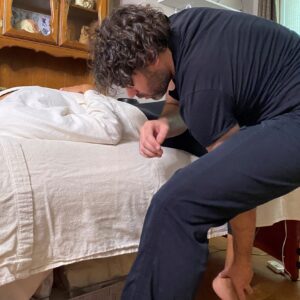
One of the most popular modern physical manipulation techniques is Active Release Technique. It’s also the technique that, by itself, looks a lot like Deep Stretch Therapy due to it’s heavy influence on the world of sports health. The earliest works describing ART are surprisingly as recent as 1985. Its a soft tissue technique that utilizes pressure and friction, along with natural and assisted movement to target adhesions and ‘deep stretch’ myofascial meridians. Kind of like a combination between Myofascial Release Technique and stretching. If you’ve ever watched a professional athlete receive manual therapy, then you’ve most likely seen ART.
During ART treatment, the therapist first applies direct pressure to a chosen knot or sore spot. Next, while keeping steady pressure to the specific area, the therapist will move the associated limb in a way that both flexes and stretches the muscle underneath the steady pressure.
The added movement and contraction increases circulation to the specified spot the therapist has chosen. When the associated muscle is then taken into a stretch, a deeper, total body stretch is uncovered. Every session allows for another layer of connective tissue to be accessed, and for a deeper stretch to be uncovered.
Active Release Technique is an excellent option for anyone from the hardcore athlete to the elderly and everyone in between. However, it’s important to understand what ART is supposed to feel like so you don’t find yourself fighting through the pain of the treatment itself. You’re body is trying to tell you something. You want the pain/pressure level to feel like it’s at about a 7 or an 8 out of ten. That’s the ideal pressure level for increasing circulation and avoiding bruising/damaging tissue.
Tip: The pressure should never feel sharp. It should always feel dull like a stretch.
Petrissage
Petrissage is an ancient massage technique used for centuries. The root word, ‘Petrir’ is French and means, to knead’ (as in dough), or ‘to wedge’ (as in clay). Petrissage has existed since the earliest conception of massage. It is the unquestioned foundation for deep massage noted by its clear prevalence in Indian and Swedish Deep Tissue Massage. Petrissage is ideal for increasing circulation to deep tissue in a general way, and is an essential foundation for Deep Stretch Therapy.
Petrissage begins the process by lifting and separating muscles form corresponding areas through traction to stretch and relax muscle fibers. It also stimulates the lymphatic drainage and helps begin the process of breaking down adhesions.
To perform the technique the therapist uses the palms of their hands to press deep tissue in opposing directions making an ‘s’ shape with the targeted area. Petrissage is best used on large areas of the body such as the thighs or the back, but can be applied anywhere depending on the size of the therapists hands compared to the client’s body. Its generally advised to begin massaging every area with some form of petrissage before applying deep pressure. The body is generally not prepared for deep specific pressure until some deep general pressure has been incorporated first. It’s like sprinting before you’ve jogged or stretched to warm yourself up. Your body knows what it needs. If it doesn’t feel right, then it probably isn’t right.
Petrissage is a failsafe technique that should be incorporated into all forms of deep tissue work.
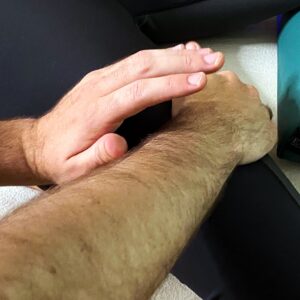
Vibration
Vibration is an extremely rare technique seldomly seen used in any industry without the use of an instrument. With unique control of certain muscles, some therapists have an ability to direct pinpoint, controlled vibrations through their forearm, into strategic areas. Kind of like that massage gun everyone got for Christmas, but it actually works!
Vibration is best used on small muscles with steady pressure directly to the area. Manual vibration is controlled directly through the fingertips of the therapist. It’s the furthest vibrating point from the body so it has more noticeable amounts of movement. Sort of like how a tuning fork acts. Vibration is used in some of the most cutting edge forms of therapy targeting balance and the central nervous system. Therapists use tuning forks and sound targeting the brain rather than the myofascial network.
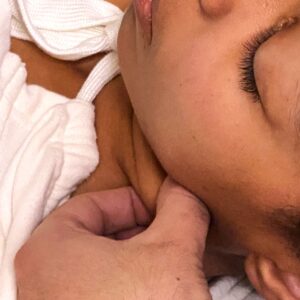
Vibration works particularly well on typically stubborn muscle groups. Deep Stretch Therapy at ESOTONE heavily relies on vibration to release the neck (front and back) and the muscles that align the spine. The advantage of using vibration in massage is that stretching isn’t always required. If a client is unable to receive a technique due to physical complications or contraindications, vibration is always an effective option.
Another way vibration can be used is through energy work. The oldest known civilizations to practice massage are in China. Eastern Chinese philosophy is heavily based in the chakra, or energy. Energy work is when the therapist holds two points on the body and directs energy flow from one side toward the other. In this work, pressure isn’t involved. Breathing and intent are much more important. However, vibration enables the therapist to access a different level of release. The same way heat or electricity is used in acupuncture.
Overall, vibration is a unique and interesting technique that has to be felt first hand to be truly understood. It’s an essential tool in the arsenal of Deep Stretch Therapy that uniquely elevates the experience.
Myofacial release Technique (MFT)
Myofascial Release Technique is a foundational technique for any sports massage therapist. MFT aims to target adhesions and scar tissue based on assessment and range of motion. ‘Myo’ means ‘muscle’, and ‘fascia’ is a global network of connective tissues that glue all the body’s innerworkings and provide the body with integrity and function. The secret to the technique is elongation and separation.
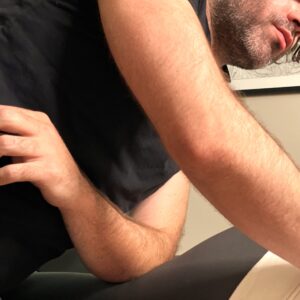
MFT uses a combination of short, small strokes, along with long sweeping strokes. Short strokes run cross fiber to muscle grain and separate muscle fibers in order to break up knots and adhesions. The elongating strokes microstretch muscle fibers along with the grain in order to smooth out and loosen muscle fibers, and ultimately melt adhesions.
A good Myofascial Therapist needs to have a strong and visceral knowledge of the anatomy of the body. A strong assessment process is vital for identifying the miniscule areas that need releasing. For each of these reasons, MFT is essential in the Deep Stretch Therapy process. When necessary, an in depth assessment utilizes observations of posture, standing range of motion, and gate or walking patterns. A trained therapist is then able to identify the proper combination of muscle releases necessary for the desired effect. For example, plantar fasciitis may require releases along the gastrocnemius and biceps femoris, as well as the planter fascia itself because they are all associated with the action behind the affected area, flexion of the bottom of the foot.
MFT should never be sharp or painful in the Deep Stretch Therapy process, but should mostly consist of a therapeutic ache, or stretching feeling. The misconception that you have to fight through the pain to receive the therapeutic benefits is just not true. Your body is trying to tell you something. The proper, sweet spot, level of pain/pressure is at about a 7 or 8 out of ten. That level of pressure tells the body to increase blood flow and circulation to that one specific spot. The goal is to stop before there’s a chance for bruising. That way, we receive all of the magical healing benefits that blood provides without going so far as to break blood vessels like more invasive methods can require.
Overall, MFT is essentially the western scientific approach to massage. Its great for work that has a specific purpose, such as treatment for chronic pain. Also, most of the techniques used in MFT are replicable without a therapist through self myofascial release (SMR). For a list of Self Myofascial Therapy techniques that replicate the Deep Stretch Therapy process, click the link below:
Chraniosacral Holds
Cranial Sacral Therapy (CST), or Craniosacral Therapy, is designed to relieve pressure and tension between the head (cranium) and the tailbone (sacrum). Neck muscles can be notoriously difficult to release. Craniosacral holds apply gentle traction to the cervical vertebrae opening access to deeply guarded trauma stored in neck muscles.
Craniosacral Therapy was developed in around 1980 by an osteopathic physician named John Upledger at MIchigan State University. It requires an extremely light as pressure generally doesn’t exceed about 5 grams. This gentle, hands on technique is designed to evaluate and enhance that craniosacral system. The craniosacral system is made up of the membranes and cerebrospinal fluid that surrounds and protects the brain an spinal chord. CST releases blockages using spinal traction and strategic pressure points. Its been proven to improve function of the central nervous system, and improve overall health and well-being.
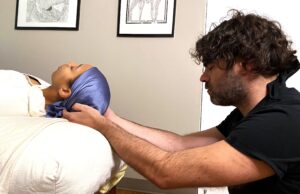
But Cranial Sacral therapy doesn’t just facilitate the bodies ability to heal naturally. It has also been helpful to address the physical components behind traumatic mental challenges such as post-traumatic stress, depression, migraines, headaches, chronic pain, motor-coordination impairments, concussions, spinal cord injuries, scoliosis, chronic fatigue, fibromyalgia, immune disorders, post-surgical dysfunction, sleep challenges, and anxiety.
If neck/spinal muscles are involved in the mechanism behind pain, as typically is the case, CST is the primary method used in Deep Stretch Therapy.
Trigger Point Therapy
The first ‘myofascial trigger point’ was coined somewhere between 1942 and 1960 by the personal rheumatologist of former US president John F. Kennedy. Dr. Janet Trevell, MD later published a book, “Myofascial Pain and Dysfunction – The Trigger Point Manual”. This book became an influential breakthrough to the field of physical health. From that point on, nearly every therapist to address the physical components to health has incorporated Trigger Point Therapy into their respective practices. Deep Stretch Therapy at ESOTONE is a perfect example.
Trigger points are most likely a major cause for chronic pain in the myofascial, and musculoskeletal systems. A trigger point is essentially a tiny knot about the size of a pencil head, or smaller. It is a phenomenon that occurs in a microscopic cluster of muscle fibers that causes them to stay contracted. It’s similar to how a shoelace will start to bunch if you were to lift a shoe by one, and spun the shoe in the same direction. given enough time, the shoelace (fascia and muscle fibers) bunches into tiny knots and eventually larger, more complex knots.

Trigger points can be difficult to identify because they typically exist nearby where the pain is felt. Trigger point practitioners are able to identify the affected area and work with the muscles coaxing them into a release. Your body is trying to tell you something. Trigger Point Therapy targets individual trigger points with a steady application of pinpoint pressure. Too much pressure, or abrasive rhythmic pressure will aggravate it, while the right pressure and patience helps achieve lasting results.
Trigger Point Therapy is an essential intricately integral part of Deep Stretch Therapy. If you would like to learn more about Trigger Point Therapy, visit this article from dgs-academy.com.
Acupressure
The term ‘Acupressure’ comes from the root, ‘acus’ meaning ‘point’ or ‘needle’. It originated in ancient China from the art of ‘Acupuncture’. It was revolutionary non-pharmacological healing invention that is able to promote health, well-being, and longevity in a non-invasive way. In common applications, acupressure is used to deter nausea, vomiting, and anxiety. If someone were to quickly describe what a Deep Stretch Therapy session felt like, they would say its mostly like a combination of Acupressure and Active Release Technique.
In Acupressure, to release muscle tension, one hand holds steady pinpoint pressure on a specific meridian point, or acupoint, while the other hand is used to balance the flow of physiological energy. From a western perspective, the goal is to release muscle tension or relieve internal pressure. Acupressure can be a great alternative to those who aren’t quite ready for acupuncture, and also a fantastic tool for all manual therapists.
The entire body is made up of a cluster of acupoints. They are essentially typical points of needle insertion in acupuncture. Over time, more and more knowledge has been added to the theoretical acupuncture/acupressure database, and different pains and usages are associated with each of them.
The amount of pressure used in the application of this method should be comfortable but firm. Less activity yields better results in this technique. The therapist is essentially trying to do their best to act like needles in acupuncture. Still and consistent. The therapists thumbs mark the acupoint of interest. The therapist holds one distal (further from the heart) and proximal (closer to the heart) point balancing the flow of physiological energy, and releasing tension, between each point.
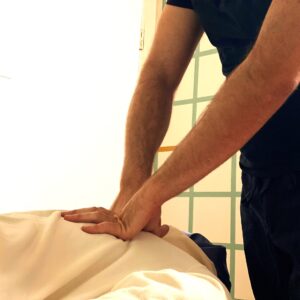
Proprioceptive Neuromusclular Facilitatioin (PNF)
PNF Stretching (Proprioceptive Neuromuscular Facilitation) is, in a nutshell, a way to ‘trick the brain’ into allowing a deeper stretch than previously thought possible without ‘overstretching’. The therapist involves natural joint manipulation along with ten seconds of antagonistic voluntary muscle contraction, releasing the targeted area. It’s used to elasticize muscle fibers and improve both active and passive ranges of motion as well as overall muscle performance. In extreme situations, such as a deep cramp, PNF stretching is the ideal tool. The muscle, or muscle groups, that are stuck in a contracted state due to the cramp are given no choice other than to relax.
It works because opposite muscles are unable to stay contracted simultaneously. For example, when dehydrated, runners and swimmers are very susceptible to calf cramps. The cliché saying when something like that happens is – “toes to nose”. The reason why people say that is because the calf is on the back of the leg. the muscle ‘the calf’ refers to is the gastrocnemius and the soleus muscle groups. The muscles that controls the opposite action, raising your toes to your nose, is the muscle that typically feels shin splints, the tibialis anterior.

You first apply resistance to the top of the foot, then press into it, and finally try to raise your toes and foot up towards your head. Like a sea-saw, both sides cannot be active simultaneously, and the less active side yields to the more active side.
Anyone interested in improving their quality of movement and overall physical ability should consider introducing themselves to Proprioceptive Neuromuscular Facilitation. “Tricking the brain” is the generally guiding rout that Deep Stretch Therapy takes to releasing muscles. Your body is trying to tell you something. It could just be saying as simple as, “this spot needs to stretch!” or, “this spot needs to activate!”. Feeling the pain is the easy part. Figuring out what the body needs… is the rewarding part. PNF stretching highlights that aspect perfectly.
